Cleaning out the years photo files I have been coming across a few "nothing" images that I like more now than when they were taken. Most were taken on my morning photo walks, usually in autumn or early winter.
OMD 75-300 at 75mm
More to come.
Cleaning out the years photo files I have been coming across a few "nothing" images that I like more now than when they were taken. Most were taken on my morning photo walks, usually in autumn or early winter.

OMD 75-300 at 75mm
More to come.
Here is an image I discovered while researching my post "Practical uses for Bokeh". It was done with an old, but effective technique.
The basic idea is the hand hold (or tripod mount) a very slow shutter speed exposure and "drift" during the exposure. This was 5 seconds at about f11 using the Olympus 25mm f1.8. I forgot to disengage the stabiliser. The image may look better or worse for it.


Here is one of the same subject matter (different angle) "normally" taken.
Variations on this are to extend the time so the image starts to become more coherent again, zoom the lens during exposure or take the bulk of the image normally, only messing with it at the end or beginning for a while.
I have a confession to make. I have never tried the C-AF function on my EM5 Mk1 cameras. I assumed it was crap. pretty much un workable and pointless.
Continuous AF on most early mirrorless cameras relied on re acquiring the focus continuously, without the benefit of phase detection, predictive AF. This means in practical terms, that the camera is always hunting "from scratch" for each frame and unless the focus and shutter fire are nearly instant and in tandem, the focus has shifted. Nikon's V cameras were the best early, partly because their sensor was smaller giving more DOF at the same magnification as other cameras.
Olympus, Fuji and panasonic lagged, Sony showed some signs of getting it right.
On a shoot last year, I needed to follow a slowish moving subject, coming towards me. Not even setting CAF, but relying on the native speed of the first capture, I mated the OMD EM5 mk1 and 40-150 f2.8 (brand spanking new) and got poor results. It turns out that there are focus accuracy issues with non firmware updated EM5's and the 40-150 lens also, but the miss to hit ratio was very poor. My critical thinking at the time was poor as I only left hospital a short while earlier, was weak and unpracticed.
The lessons relearned were; know your cameras capabilities better, don't use new gear untried and don't forget old skills (MF etc.).
Last week I had a chance to try CAF out. Surprisingly it was not rubbish (I am often surprised by the EM5, even now). I think the only real difference s the continuous re focussing rather than the limitations of one shot focus, then re focussing. Why have I not used it before? No need for most of my work and my early experiences in a camera shop where I worked often ended up being in direct comparison to super fast tracking cameras like 5D mk3's.
It tracked a fast moving 3 year old at reasonably close distances and a series of speed boats at about 100 meters, all moving quite fast. There were misses, but there were plenty of hits also. Would I advertise to shoot sport full time? No. I will however trust the camera's (especially the newer Pen) to be faster than me in tracking situations and chase sport when a newer PDAF camera comes along.

EM5 mk1 with C-AF 40-150 at 150mm f4.
Reflecting on the life and future demise of the OMD "fleet", I could not help but think of Eric Kim when he talks about tricks to stave off "G.A.S." or Gear Acquisition Syndrome.
One of the tricks is to look at old launch and newer, user reviews*. These help to rekindle the excitement and positivity felt about the camera when new. The camera industry deliberately cycles terminology, jargon and expectations though generation after generation, with little or no regard for previously "must have cameras". The wording (promises) of a camera add from the 1990's strike a very similar theme to now. This is even starting to effect lenses, usually a longer term purchase.
*This bought up firmware updates, that can make an older camera a little newer, especially in focus accuracy for old OMD's.

OMD with 25mm at f2.8
The image used in this post reminds me that the old OMD cameras have always served faithfully, giving vibrant, sharp and rich images. They have often been compared to full frame cameras in quality (usually the D800 series!), with directly comparable results in prints up to 40" (see Pekkapodka, Dennis Mook etc) and I have NEVER had any sensor dust or oil splatter issues on any of my 5 Olympus bodies.
Any perceived issues with colour or image depth in comparison to brands such as Canon and Fuji have been shown to be in my head with processing easily removing the difference. They have also held up well against their own later offerings in real image quality terms.
I even find the video to be sharp and clear, even if it is limited in options.
I only have to use another brand for a few hours to remember that the grass is not greener.
My only two complaints are a dial top coming off one camera (fixed with some double sided tape) and relatively poor tracking focus (but not as poor as assumed).

A little closer.
Life in the old girls? In the immediate future for many tasks yes. I will have to get some firmware updates done and maybe look at an EM1 Mk2 for focussing or wait for a newer, lesser model with tracking, but maybe I will never need it.
We are off the japan again. meg asked me what I would like for my birthday (significant one) and we started thinking of travel. Inevitably Japan came up and the gods smiled. For as much (or less) than it costs to go to Sydney from here for a week, we get 8 days in Japan. Kyoto and surrounds only. A nice relaxing culture boost.
Gear and bags are a game I like to play for awhile before any trip, but this is an easy one as their is no pressure.
OMD EM5 mk1 x2. Both of my older ones, one with long strap. probably their last hurrah as my premium kit, with the Pen and possibly an EM1 mk2 coming (you hypocrite Rod!).
my 17mm and 45mm primes as the perfect street/found things combo. The "eye" lens 45mm and the perfect long draw Bokeh 17mm grab lens.
75-300 for the power it gives without too much hassle.
For a bag, I think I will use my Filson green field bag. It is lovely and has not been used much since the Filson field camera bag arrived. It is not an ideal camera bag, but for a small kit and other stuff (spring in Japan can bring anything weather wise), it will work well.

Next year we are going again in winter. That will be the premium kit of pro zooms, 25/75 and tripod for night and winter scenics, but this trip is more about just enjoying the places we have been.
A few years ago, my father in law and I attended the Longford "flying mile" vintage car event. The event is a celebration of the Formula 1 race that Longford used to host back in the 60's.
At the time I was shooting with Canon crop frame (450D) cameras after doing without full frame for a long while. Temptation got the better of me again and I borrowed, with the intention of buying, a 5D mk2 for the event.
One of the images below was taken with the full frame, two with the 450D and one with my EPL3 Olympus. The Olympus was sporting a kit lens, the Canons shared a 35(55)L and 135(210)L combination. All of the shots were taken in the open or under a white tent cover.
After the event, I printed a composite poster of the images and often used it as an example of the difference between full and crop frame. It was good for showing that fewer pixels on a smaller sensor could fool anyone (our visiting Nikon rep for example) with similar processing up to pretty reasonable sizes.




The answer to the little riddle? The Olympus image is the most obvious- the helmeted figure. It's sharp and very clear, but looks 'thinner" than the Canon ones. Part of this is due to the brands' look, but much of the difference is in the Canon-centric processing style used at the time.
The red and black bonnet is the full frame image, the others are the 450D, but really you can only tell when 40" prints are made.
Yes I bought the 5D mk2, but the Olympus "rot" had set in, just waiting for the right camera and a few more lenses.
(Shouted in a thick Irish accent), "It has a five bladed aperture, not nine, or seven, but five bladed" to quote (loosely) Monty Pythons' The Life of Brian.

Pen F with 25mm f2.8 original Pen lens at f4.
A few more thoughts on the ancient 25mm for 1/2 frame Pen cameras. Kirk Tuck states that the Pen lenses can be as good as the new lenses, with the 25mm being one of the reliable, but not special lenses, still capable of pleasant surprise or two.
The shot below was one of the better focussed efforts taken last night in poor, but workable light. The intent of the designers was clear. Sharp, clear and contrasty with fair but not extra ordinary fine resolution. Could they resolve more in the days of yore? That is beyond doubt as even some of the lenses from this range and plenty of macro lenses etc from this period or a little later are stellar. This lens would be a slightly wide angle on a Pen 1/2 frame (the standard being a 38mm), so the design would probably be as much about bokeh as sharpness.

Pen F 25mm f2.8 "old croaker", f 5.6 ISO 800, hand held.
The above image is fully processed, with minimal sharpening and the 100% crop below is slightly sharpened.

Not too bad for a 50+ year old lens.
A newer, prime or pro zoom lens would show higher fine resolution, but that is expected in the pixel peeping world of today. At normal viewing ranges, the difference comes more down to the rendering characteristics. Compared to my 25mm f1.8 the lens shows slightly more "nervous" bokeh, but possible a deeper looking, more 3D rendering. More on this later.
The only real thing to gripe about is the 43mm filter thread, making a hood a hard thing to find.
Scrounging around in the junk bin, I found a screw on Canon video camera 1.4X teleconverter. Not my favourite thing in the world. Hate this kind of poor fix idea actually, but the thread fit my 45mm and the day is wonderful, so a bit of experimenting was to be had.
First up, the close focus was not improved. Shame. Sometimes these things can add a little something to your kit.
Secondly, the thing is sharp.
A couple of things to note about quick fix close focus options.
Extension Tubes are optically pure (no glass), but are fiddly, loose light (1/2-2 stops depending on length) and are more powerful on short lenses.
Screw in diopters are (usually) less well optically corrected, don't loose much or any light and are better on longer lenses.
Tele converters are a good option if they are good to start with. The lens gains 1.4 to 2x magnification, but the minimum focus range stays the same.


The crop and the full size image. It turned out to be a great working distance for insects, but not close enough for serious work.
Next up, the Olympus 25mm....from a million years ago. Kirk tuck is a big fan of Olympus Pen lenses from the original half frame era, but the 25mm I saved from the tip during a work clean out is not one of the best of the bunch.



The first image is the slightly hazy, low contrast original. The second is the same image with a preset applied (called 70's designed to look like the 1970-80's film era) and the last is from the new 25mm f1.8, all shot at f4. The difference in the bokeh is noticeable.
Not lens focus or sensor resolution, but new years;
1) No more peeking at images at 100% (except for editing precision).
2) Print more.
3) Get another good year out of the OMD EM5 mk1's, then look at (maybe) upgrading.
4) Be more productive.
5) Be less retrospective.
6) Travel, Travel, Travel.
7) Be still* more often.

OMD 25mm f5.6
* contemplative, relaxed, observant, aware.
A few years ago Steve Huff blew many away with his success in recovering highlights from an OMD file using Photo Ninja. At a time when many things were being questioned when thinking about smaller sensor cameras, it came as a revelation. My own experiences with Canon highlight retention/recovery issues on their crop frame bodies primed me for a solution (actually the solution was Sony made sensors in general and to a certain extent still is today).
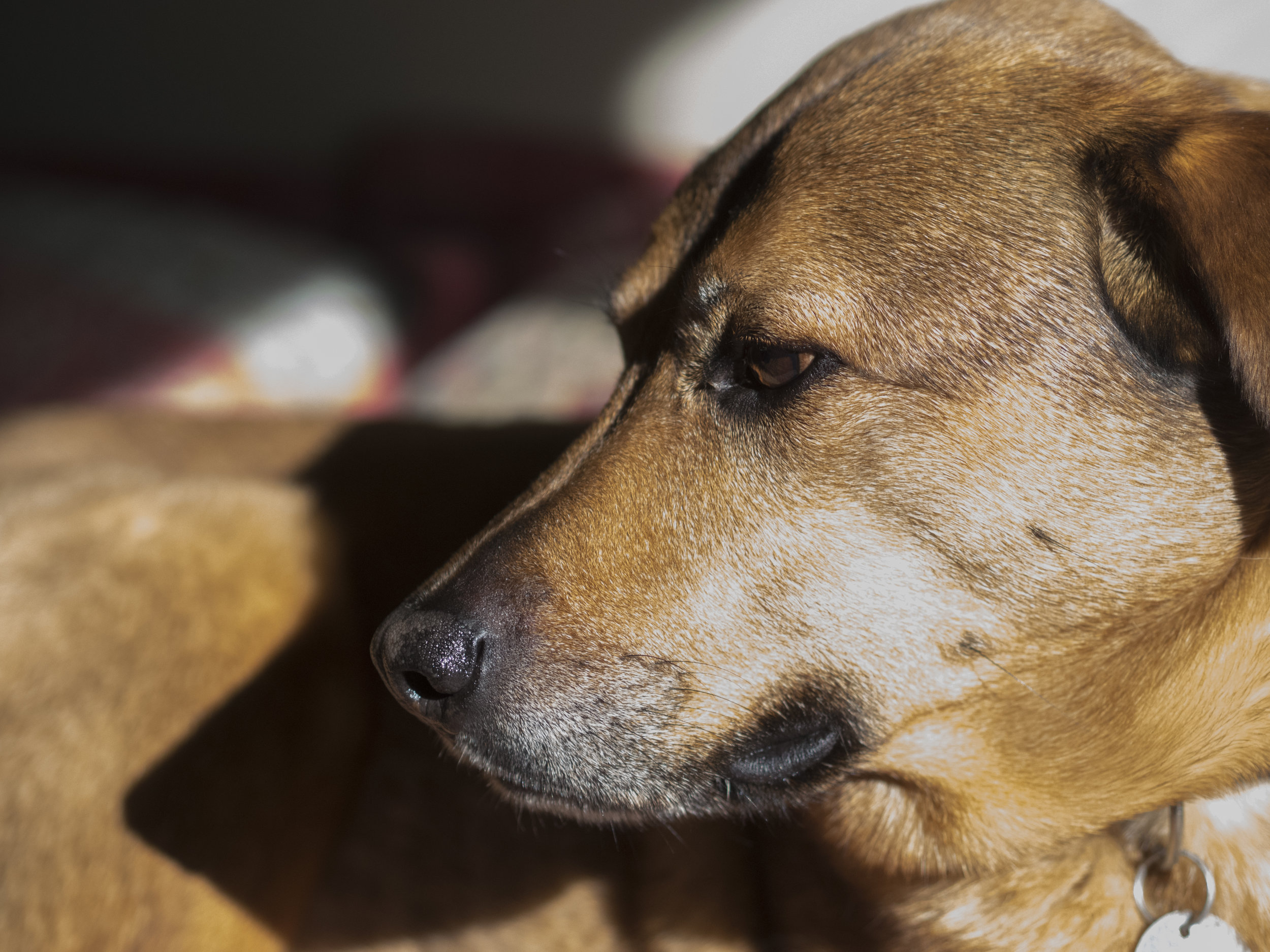
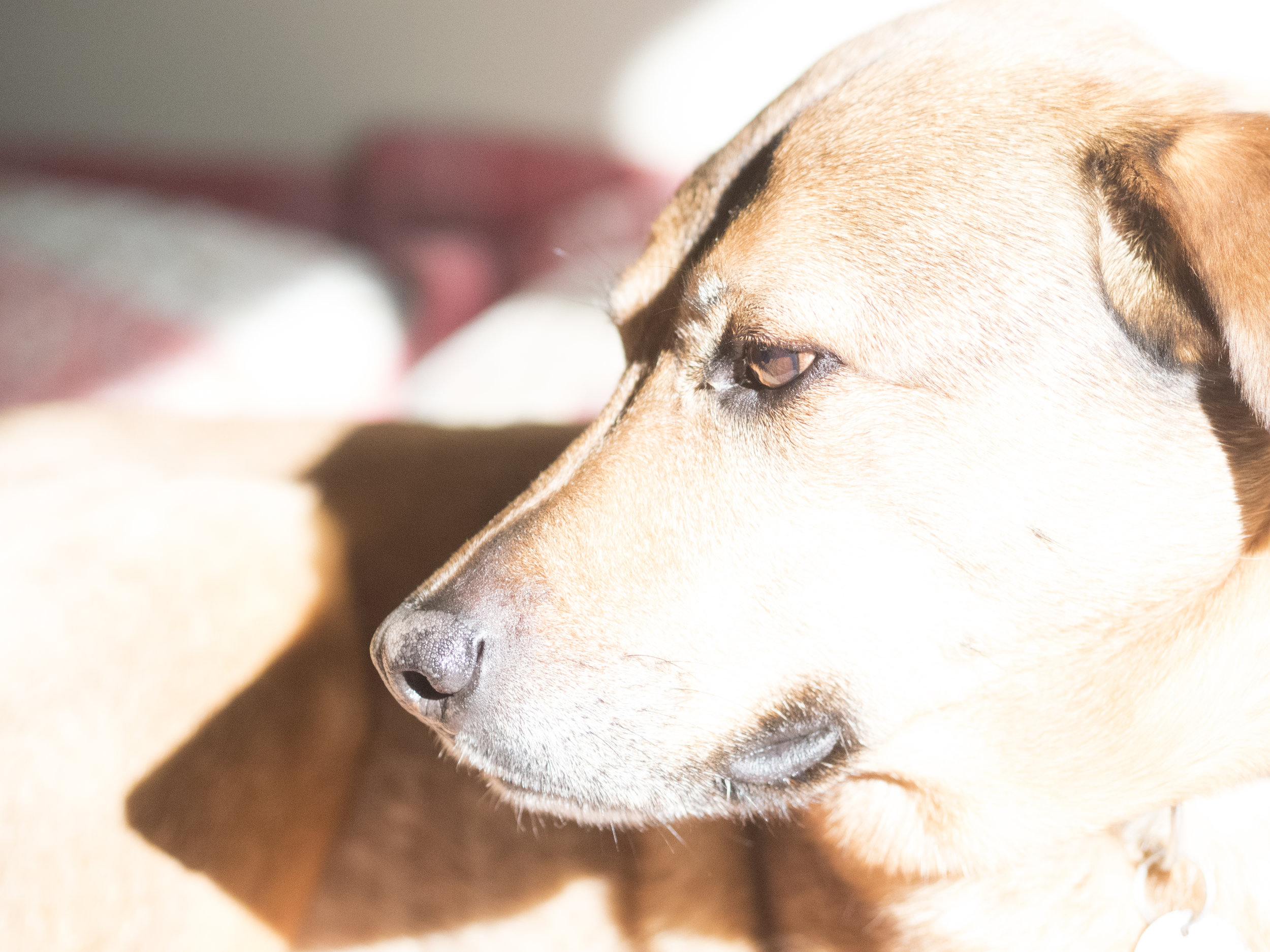
A bit of a stuff up the other day. ISO 3200 setting used for strong light shots, and no SCP on. OK, I thought with happy anticipation, that I could try Lightroom's recovery of the Pen F images in much the same circumstances as Huff's images. Exposure reduction, and the highlight slider in the negatives to tame the effectively white cheek, without having to resort to contrast reduction.
The colour is a bit flat (no attempt to fix that), but the grain is very tight. A trick to remember when shooting high ISO images, higher than your camera likes; Set the ISO higher than needed and over expose and if possible reduce the file size (in RAW if available). Both of these things will help tame noise.
Tough gig being Santa in Australia. 30+ degree heat, heavy red suit, fake beard and then they give you a hard wooden chair.

Pen F 25mm f4
I am always suspicious of new gear until I start turning out images that (a) I like and (b) stand up against images I have taken in the past in similar circumstances.

All new Pen F and 40-150 at 135 f4.
I also have to take into account the dirty window glass and flare that were part of the process.
My parents in laws' garden has some exotic surprises.

OMD EM5 mk1 75mm at f5.6
Just another example of the excellent street photography benefit of the Olympus 17mm's Bokeh. This was shot (late evening-darker than it looks) at f1.8 with focus hitting the back of the mans Kimono, but the transition backwards is so coherent, that the focus area looks to be much wider. Even the sign across the road is almost readable and the lady with the umbrella is also quite defined.

Pen F and 17mm at f1.8
There is a pleasant mix of foreground "snap", without the background being too overtly blurred. It's an old fashioned thinking, made to be of practical benefit, not a deliberate, fast drop off Bokeh in the more modern style. The same image taken with the 20mm Panasonic or the 12-40 zoom (even at f2.8) would show a faster drop off to softness which some will preffer, but for street shooting shows focus misses too aggressively. Bokeh has no wrong or right. Like texture, colour and contrast, it has it's different forms to suit a variety of situations and tastes.
The Pen F has a few jpeg based features that are already well thought of. Fuji (mostly) and Olympus have been developing their jpegs to new heights in film simulation and usability and the newest Olympus offering aims to simulate the look of Kodak Tri X film (or any mono film with a strong mid tone curve and rich, gritty contrast).

Pen F with 40-150 at 150/f2.8 ISO 1600
The camera has become a solid friend, out performing the OMD EM5's enough to be considered the safer bet in work conditions. The Tri X-looking mono stirs up memories of long hours spend in my dark room, looking for the magic image and taking every little morsel offered. I prefer a slightly less contrasty image with brighter and lighter tones and clean, tight grain (more FP4 like), but the look is genuinely "filmy".
I really hate buying new. It's not that I don't lust after beautiful glass and cool looking new cameras, but I hate the process.
When I worked in a camera shop, I developed the habit of not buying before trying and two things happened. I either did not take to the new gear pretty quickly, saving the hassle, or if it suited my pre conceptions I would then test a potential purchase against several of it's siblings to make sure I got a good copy.
Often my rudimentary* testing could not clearly pick a poor lens from a better one and if this was the case, there was not a problem big enough to find. After a lot of this, I rarely found a bad copy but the fear was still there of spending my hard earned on a "dud". One of the reasons I switched to M43 was the consistency of the lenses, both in performance and variation.
Enter the 40-150 f2.8, bought on faith and without comparison. Nothing but good things have been said about this lens, but I was suspicious of it until proven otherwise. My first job with the lens, after some basic tests was a disaster (NEVER use new gear on a job until you are fully conversant with it). The images taken of slowly moving subjects on a bright day were soft- "soft focus lens" soft. Tests had proven the lens to be as sharp and clear as my 75mm (at close distances and indoors) but these images displayed a hazy fuzziness with blown out highlights that were unworkable (think mobile phone photos pre smart phone).
Unhappy with the lens, but having had it awhile, unused due to poor health, I felt like I was stuck with it. More testing pre sale, just to make sure.
All images were good !?!
It is a bit sharper and crisper than my much loved 75-300 and matches the 75. What to do?
Today I think I have nutted out the issue. Edit; looks to be a firmware issue to.
The two images were taken within seconds of each other with identical settings, but different focus pulls. The only thing that could be different is the point of focus. On checking, the hazy image has no better focal point closer to the lens (both are heavy crops), so the focus miss must be behind her and the slightly more coherent bokeh supports that.
On checking the original shoot images, the focal point is just behind the subject also.
When the lens misses focus to behind the subject (an issue with moving subjects on EM5's) , the resulting foreground bokeh is very soft and hazy**, almost glowing. This looks to be a mostly bright day phenomenon so far, greatly exaggerating brilliance and the lens also looks to over expose a touch which does not help.
I must admit, this has firmly relegated the two zooms to the scenery work they were purchased for as I just don't get the snappiness from them that I get from my primes and that outweighs the convenience benefits. Stopped down and used carefully they are excellent, but for wide open portrait use they are neither consistent nor fast enough.
*In the past I would do a bookcase test, viewing identical images at 100%, then I switched to corner tests as that looked to be the first indicator of trouble, but lately I just take images in good light hand held with the different lenses, but the same camera, choosing off centre focus targets. If the issues are bad enough to see this way, they are bad enough to matter. Remember, a lens as good as the best image it can take, not the worst, but consistency is key.
** Lightroom 6 has the new dehaze feature on both the brush and effects palettes, helping to negate the issue.
Japan entices with many stereotype images that are often as obtainable as your imagination hopes they will be.

But not always.
Kyoto is famous for, among other things, it's bamboo groves. The temple areas on the outskirts of the city are especially bountiful, but on our first visit the weather was not. Slow, hand held lenses in wet and overcast conditions are a tough call, even for the capable little OMD's, but occasionally a composition appears to save the day.
The camera was the OMD and the lens, the 75-300 zoom at about 100mm.
Urban decay has always drawn me. Maybe it has trawling through old magazines as a child with romantic ideas of travelling to third world countries (and changing them of course, we thought a photo alone could do that back then), seeing abstraction in details or just being drawn to worn down and "storied" places.

Doing one of my early morning photo walks, I stumbled on this image in an abandoned office foyer. One of those places that show neglect now and only highlight the "after thought" nature of the original place. I could barely be bothered to investigate, but on looking close, I discovered the plant was not a fake and was somehow thriving in its squalid location. Moved by its effort to survive, I became determined to capture its struggle and composed the above image through a panel of frosted glass (the only one facing the sun). beauty can be found everywhere,
The camera was the OMD and the lens the 25mm at about f4. There was a little post processing to get rid of the less attractive spots of bird poo, but otherwise it's as was.
After a long while focussing (no pun intended) on street and portraiture photography, I have returned to, or intend to return to landscape photography as well. The streetwise Pen F and action oriented 40-150 Pro were purchased against their own marketing assumptions for this purpose as I have had the 12-40 for a while, but lacked an unbroken range from wide angle (24mm equiv) to medium telephoto (300mm equiv) and a kit with consistent quality across the frame and through the range.
One of the weaknesses of my previous SLR kits was in the use of long lenses for slow to medium slow shutter speed exposures (5 sec to 1/125th). Vibrations that are hardly noticeable, even to touch, are severe and unforgiving when everything is stretched to the limit. Longer exposures have some settling down time and shorter ones can even be hand held, but these shutter speeds are the "sweet spot" of frustration. Heavy tripods with mirror lockup and cable releases applied, tripod collars used when required and a few other tricks such as "weighted" tripods and supporting metal rulers under the lens all failed to arrest quality robbing vibrations.
The Pen F sports two things that I hoped would eliminate the problem. It has an electronic shutter that creates no vibration or sound and can be fired using a variety of methods from a gentle touch on the back screen to mobile phone wifi release via an app. Using the first method, my work routine became (very quickly), mount the camera, compose, polarise to cut out reflections, then gently touch the frame where the image was best focussed, firing the camera after a short delay. No noise, no mechanical hints or distractions, just pure image taking, fast and efficient. The quiet gentleness of this system is ironically most similar to using an old leaf shutter or my ancient 1970's Canon F1 SLR with its cloth shutter and mirror lock, so we have come full circle (lets not talk about the clunky T90's).
Today was the perfect day to test the kit out, being still and wet with a high over cast cloud cover. So with polarisers attached and my meagre remaining tripod option in hand off I went. There is always some expectation of failure when a theory is tried out in practice* but my confidence was bolstered with a strong determination to succeed.
*Mathematical theory does not often survive scientific experimentation.
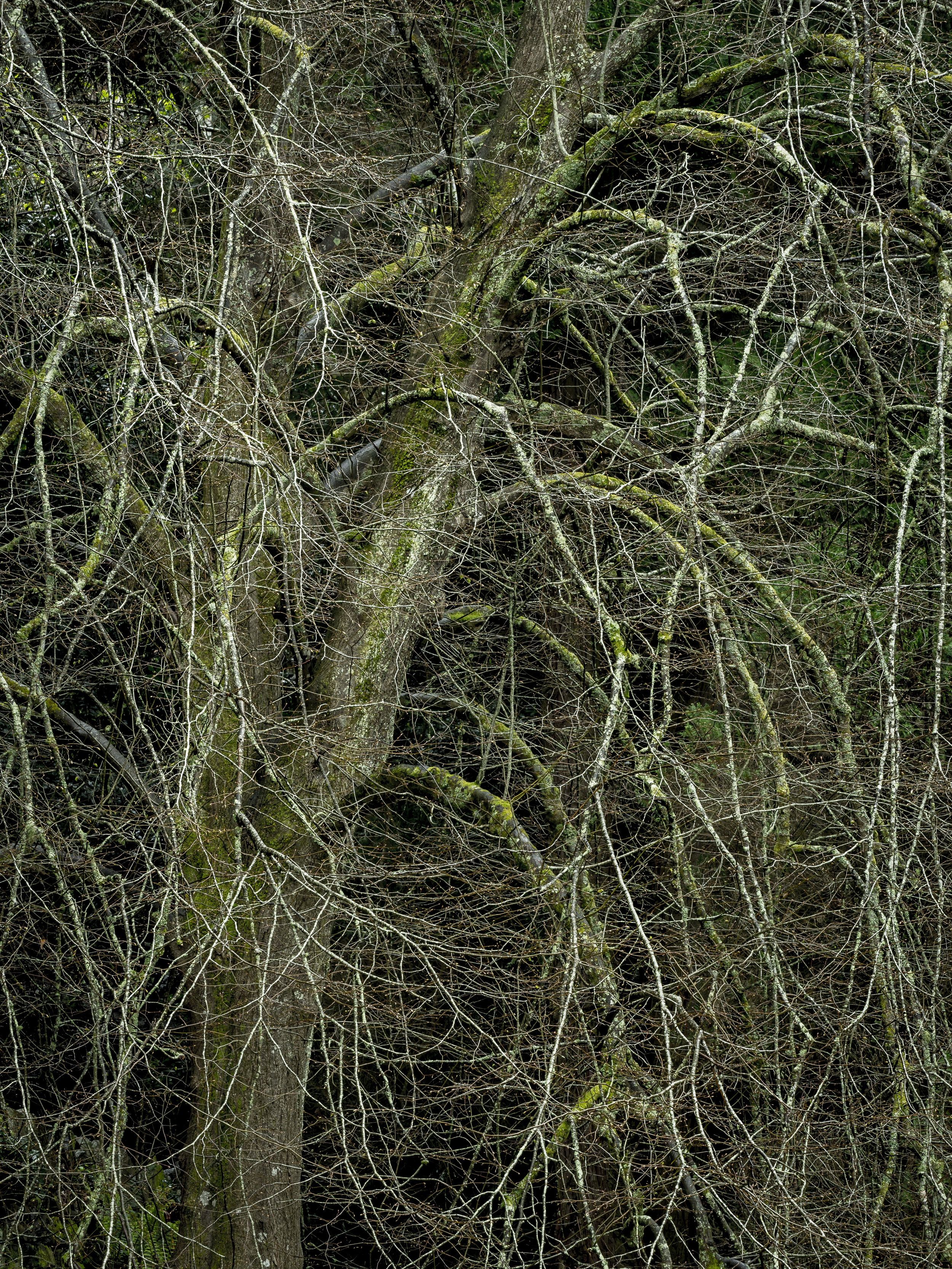
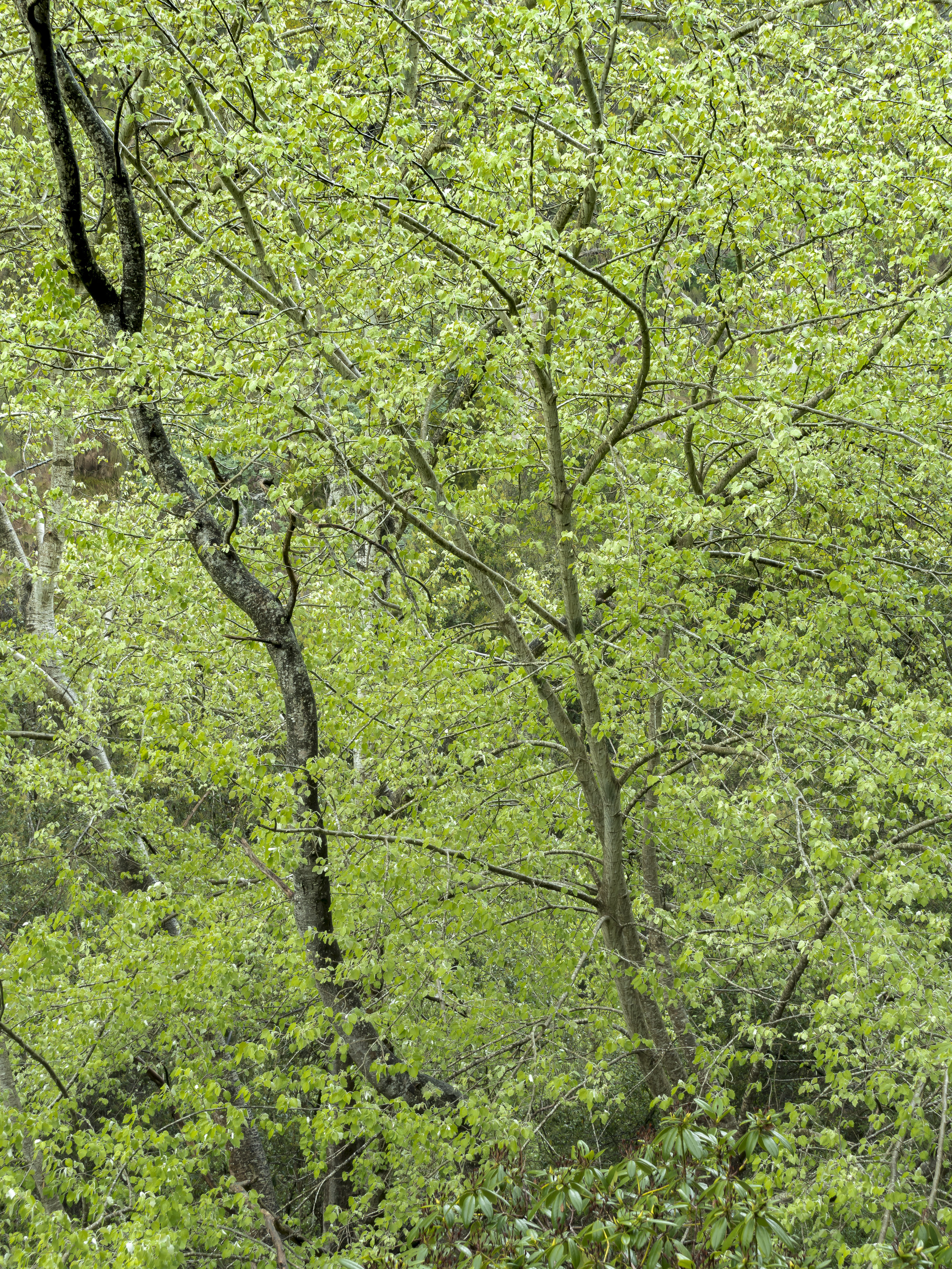
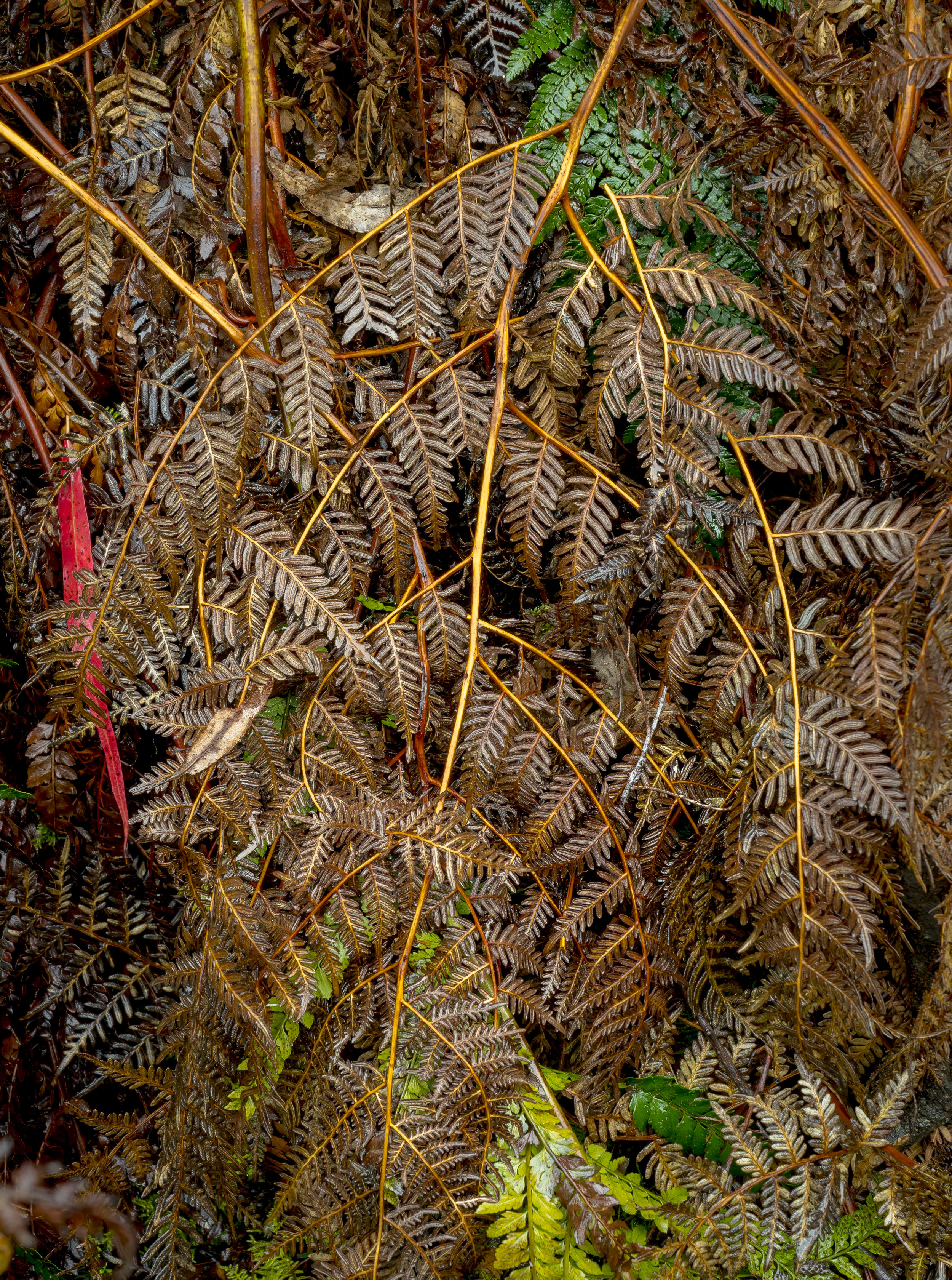
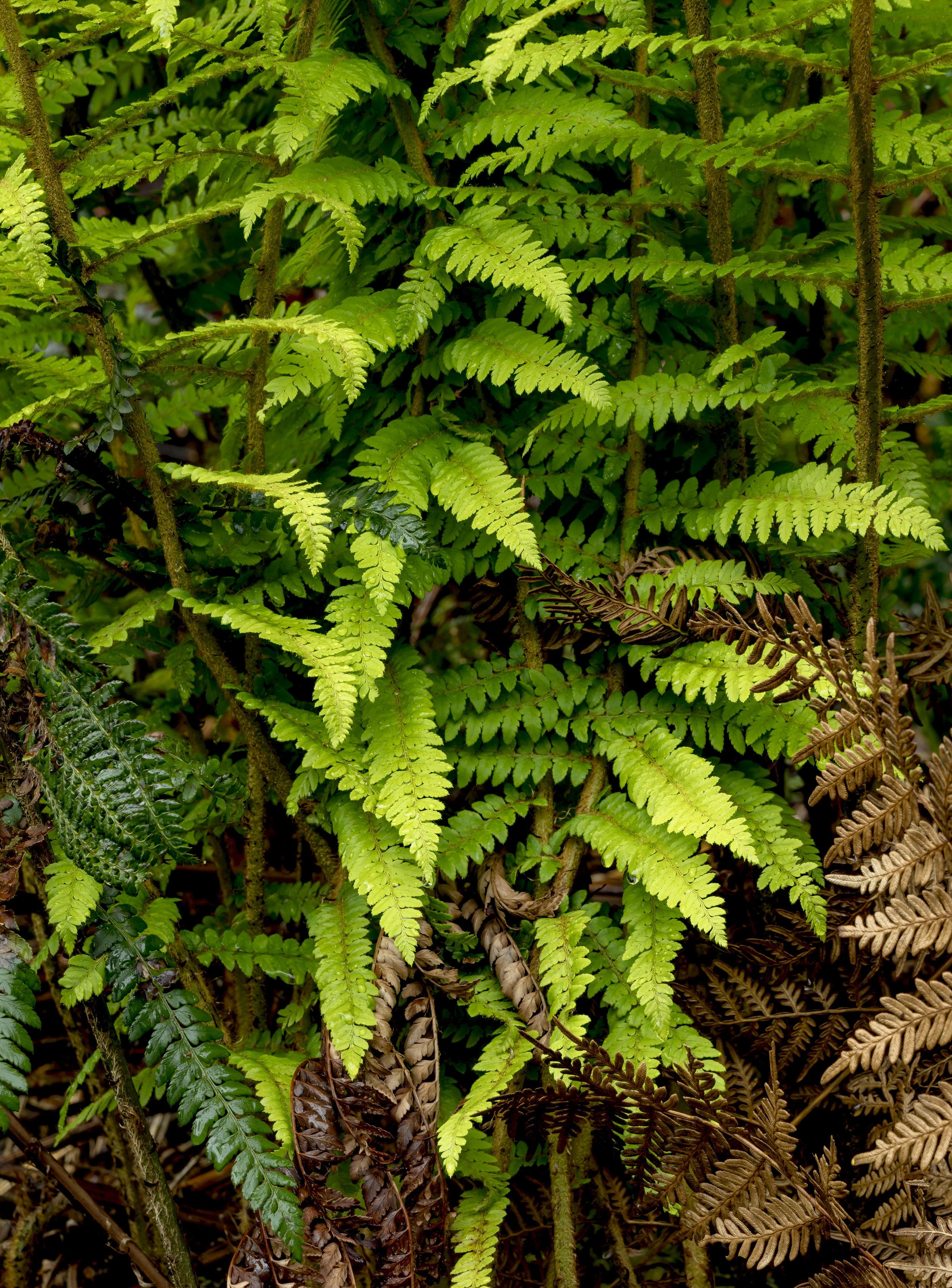
These 4 were taken with the 40-150 at iso 100 using shutter speeds in the 1/15th of a second range. All the images in this post were taken within 100 meters of each other in the Cataract Gorge, Launceston. The compressed upload does not go close to showing the full detail....exciting!
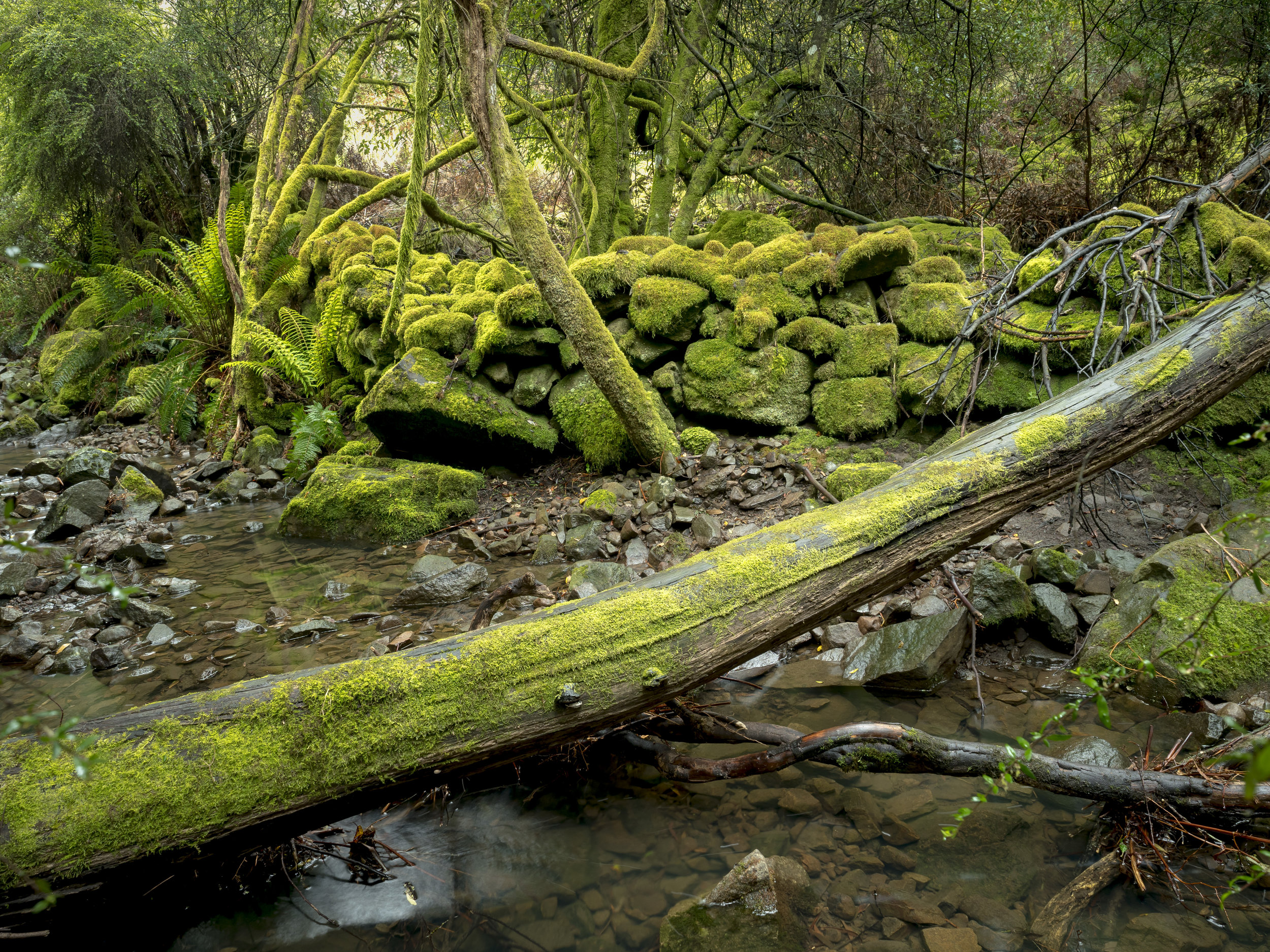
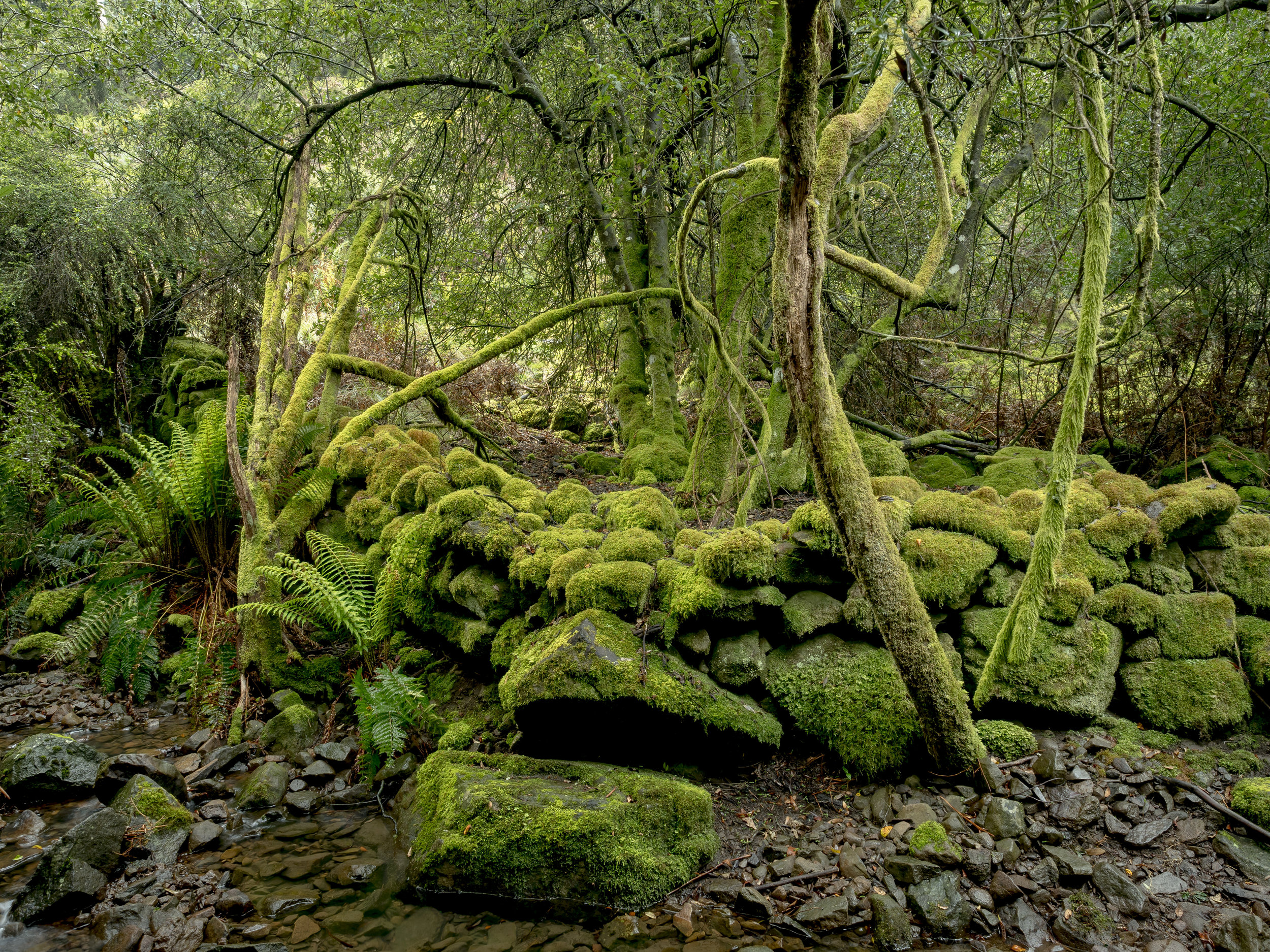
A couple of wide angle shots from the same places. I toned down the fluorescent greens in post (tones accepted on a Velvia slide, assumed to be fake in digital!).